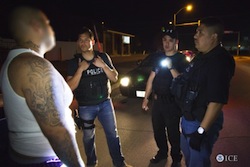US authorities have arrested nearly 1000 gang members in a nationwide sweep called “Project Wildfire,” amid evidence that the gangs have links to Mexican drug cartels which could indicate the growing reach of Mexican criminals within the United State.
Project Wildfire, a joint Homeland Security and Immigration and Customs Enforcement (ICE) operation, pulled in 976 gang members from 239 different gangs, in 282 cities across the United States, according to an ICE press release. While the majority of the arrests were US citizens, the hardest hit gangs have extensive transnational ties.
The US-Mexico border region saw the most arrests, but the operation reached as far as Detroit and Chicago, where authorities captured members of the Latin Kings and Sureño 13 — both of which have links to the Sinaloa Cartel.
Police arrested 116 gang members in El Paso, a stronghold of Barrio Azteca and Sureño 13, two gangs that operate in multiple US states and play a major role in narcotics distribution for Mexican drug trafficking organizations, according to the El Paso Times.
In the operation, which lasted from February 23 to March 31, police also seized 82 firearms, 5.2 kilograms of methamphetamine, 7.8 kilograms of marijuana, 5.6 kilograms of cocaine, and 1.5 kilograms of heroin.
InSight Crime Analysis
In recent years, the relationships between Mexican criminal organizations and US gangs have evolved. While Mexican groups usually tend to subcontract narcotics distribution and contract killings in the United States to gangs, some groups like Barrio Azteca, a prison gang that originated in Texas, and Sureño 13, have formed stronger partnerships with Mexican cartels.
Barrio Azteca made an international expansion from the United States into Mexico, where its gang members worked as foot soldiers for La Linea, the armed wing of the Juarez Cartel, during a brutal battle for control of the Mexican border city Juarez, which set the stage for the Aztecas to make the jump into transnational drug trafficking.
SEE ALSO: Barrio Azteca Profile
And Sureño 13, a gang that evolved out of the Mexican Mafia in California, took over many Texas drug corridors with help from the Sinaloa Cartel, according to the 2014 Texas Gang Threat Assessment.
Closer relationships with US gangs allow Mexican groups to outsource the risks of entering US territory. Indeed, as the major cartels splinter and fragment in Mexico, there is some indication that an increased reliance on kidnapping and extortion as revenue streams has spilled across the border. For instance, an officer from the Los Angeles Police Department recently said they were receiving reports of extortion calls originating in Mexico that target Latino residents in the United States.

